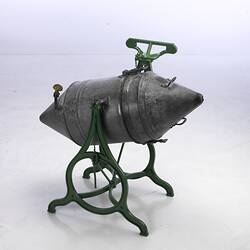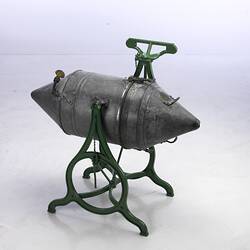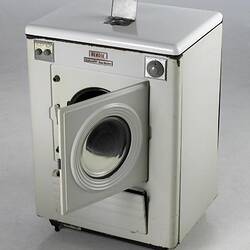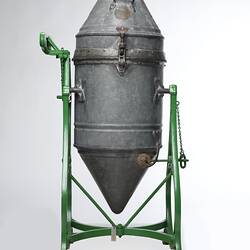Late 19th century compressed-air washing machine, made in Melbourne by manufacturers Wolter and Echberg.
This is an early example of a mechanical device designed to minimise the drudgery of washing clothes. The washing machine is made of galvanised steel and has a distinctive rocket-like appearance, with a central drum consisting of two cone shapes on either end of a cylinder, in which the clothes are washed. On the drum are two welded handles and a manual lever. The drum is attached to a four-legged iron frame from which it pivots, so that it can be rocked from end to end and turned in a full circle.
The simple but innovative design of this washing machine used minimal water, however, housewives still required a strong arm to swing it back and forth on wash day. The user operated this washing machine by placing the dirty clothes, soap and water inside the machine, sealing the lid to make it watertight and then rocking the machine from end to end, using compressed-air to agitate the dirty clothes against the corrugations inside the drum, thereby creating suds and removing the dirt. The user would then have needed to empty the drum of soapy water, refill it with rinse water and agitate it again to remove the soap residue.
The first machines to aid washing had mechanisms that worked through agitation, suction or friction. The first British patent for a washing machine, under the category of 'Washing and Wringing Machines', was issued in 1691. The manufacturers of the Wolter & Echberg washing machine, Friedrich Wolter and Hans Echberg of Russell Street in Melbourne, applied for a patent in 1875 for 'improvements in clothes-washing machines'. The basis of their application was the addition of the corrugated semicircular lining inside the tub. As similar inventions had already been patented, their patent was only partially granted and applied only to the corrugated lining.
At the time this machine was made, washing machines would have been operated almost exclusively by women, reflecting the gender roles and expectations of women in the late 19th century. Women at the time only comprised about 20 per cent of the paid workforce, and most of these women were employed in domestic labour. Men comprised the majority of the paid workforce and were generally not expected to participate in household chores.
Washing was an arduous, time-consuming task and during the late 1800s women generally dedicated a day per week solely to doing the washing. They would light a wooden fire under a large copper barrel called a 'copper', and scrub the washing by hand on a wooden scrubbing board before boiling it in the copper and hanging it out to dry. The innovation in domestic technology that this washing machine represented saved time and effort for those who could afford it. However, unlike the situation in factories, where expensive machines that minimised production time and saved on labour costs achieved cost savings, domestic work for the family was unpaid and investment in domestic machines did not achieve financial savings.
This machine was an improvement on earlier attempts to make an affordable and efficient domestic machine that would save the user's time. Before 1900 most washing machines were powered by hand, with some attempts being made to use available technologies such as water or steam power. However, the invention of the first electric washing machine, patented in 1910, was the true turning point in washing machine design, leading to washing machines becoming real labour-saving devices.
More Information
-
Keywords
-
Localities
-
Authors
-
Article types







